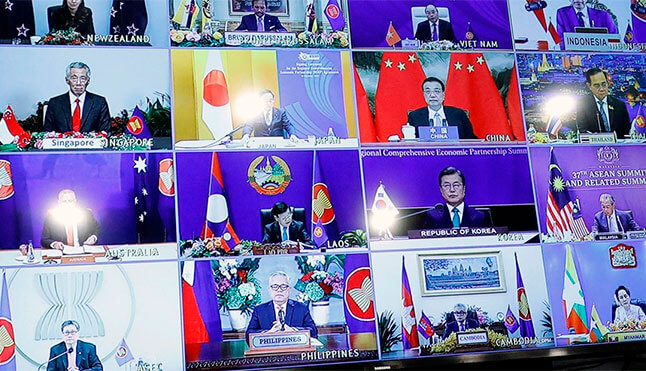
The agreement between the 10 countries of ASEAN (Association of Southeast Asian Nations), and the Tripod constituted by China, the second largest economy in the world (US $ 14.1 trillion / 15% of global GDP), Japan, the third largest economy in the world system (US $ 4.9 trillion), and South Korea, the sixth largest productive system on the planet (US $ 1.6 trillion), to which Australia and New Zealand must be added, has become the largest free trade area of the XXI century, above the European Union (EU) and the New NAFTA / USMCA (USA / Canada and Mexico).
The fundamental link between these two sub-spaces - Tripod + ASEAN - is the People's Republic of China, which is the main trading partner of the 10 ASEAN countries and the other members of the Tripod.
This is not surprising: China is the main trading partner for 144 countries in the world (out of 192 represented at the United Nations / UN); and at the same time it accounts for 35% of the growth of the global economy in the last 10 years (15% US); and this is a consequence of the fact that its current account surplus, which reached 11% of GDP in 2011, has now become zero or negative, due to the fact that it imports three times more than it exports and would buy US $ 40 billion (US $ 30 billion in goods and US $ 10 billion in services) in the next 15 years, a period in which its gross domestic product would double, taking it to US $ 30 billion, while multiplying the per capita income of its population by two, which would reach US $ $ 20,000 annually.
The key to the China / ASEAN relationship is that the People's Republic is the largest foreign investor (FDI) in the 10 Southeast Asian countries. In the first three quarters of 2020, Chinese FDI in ASEAN reached US $ 10.72 billion, an increase of 76.6% annually.
Chinese investment in ASEAN is more than 80% of the total; And this occurs while trade with Southeast Asian countries climbed to US $ 641.5 billion in 2019, and was only US $ 292.8 billion in 2016.
The China / ASEAN exchange reached US $ 416.6 billion in the first 8 months of 2020 (+ 3.8% annually), which means US $ 16 billion above the exchange between the European Union (EU) and the People's Republic, which until now was the first in the world.
When China joined the WTO (World Trade Organization) in 2001, the trade with ASEAN was less than 60% of what it was with the EU or the US; and the situation was reversed as of 2010, when the People's Republic began to grow exclusively on the basis of its domestic demand (93% of the total); and that immediately made it the main commercial partner of the 10 countries of Southeast Asia.
The core of the RCEP (“Comprehensive Regional Economic Agreement” / ASEAN + Tripod) in global terms is the link between Japan and China.
Japan is an essentially exporting economy, representing 80% of the GDP, necessarily directed abroad, which faces a situation of chronic depression, with periodic outbreaks of deflation, in the last 30 years.
From 1990 to 2018, the rise in Japan has been 0.8% per year on average and 0.4% per year the level of inflation, with a per capita income that was similar to that of the United States in 1980 and today it is a third lower.
The Japanese population is the oldest in the world (62 years of average age, with 35% over 75 years), whose main trading partner has been China since 2017, after discarding the US from the first place, which was the link essential between Japan and the global economy from 1945.
Total Japanese investment in the People's Republic amounted to US $ 124,000 million in 2019, with 23,000 Japanese companies operating there, including the 100 largest transnationals.
Hence, the exchange between the second and third world economies amounted to $ 317 billion last year.
The free trade agreement within the Tripod implies the accelerated integration between the second, third and sixth economies of the system guided this crucial process by the investment and transfer of transnational companies of the members of the Tripod. This is the logic of globalization and the world integration of capitalism in the conditions of the 21st century.
The new RCEP cannot be understood with the categories of traditional geopolitics, prior to globalization and the unification of the system. It is also absolutely alien to the purely rhetorical discussion between multilateralism and unilateralism, which are formal categories, foreign to the new historical epoch.
The central strategic data of the time is the definitive, irreversible unification of the system, led by the vertiginous expansion of the technological revolution of digitization.
The IMF warns that China would achieve a staggering 8.2% expansion in 2021, while the new RCEP would grow 6.9% in the same period.
The People's Republic would have an annual increase of 3% in 2020, after having sunk 6.8% in the first quarter, recovered 3.2% in the second and 4.9% in the third, anticipating a 6% / 7 boom % in the room.
The post-pandemic world shows a phenomenal recovery. The optimism / pessimism categories are too mediocre to capture this magnificent picture.
clarín.com
